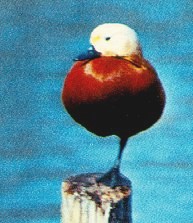 Synonyms: Casarca
ferruginea, Anas ferruginea Ruddy.
Synonyms: Casarca
ferruginea, Anas ferruginea Ruddy.Tadorna ferruginea (Pallas, 1764)
 Synonyms: Casarca
ferruginea, Anas ferruginea Ruddy.
Synonyms: Casarca
ferruginea, Anas ferruginea Ruddy.
Common names: Bulg: Cherven angach; Engl: Shelduck; Rom: Califar rosu; Russ: Ogar'; Turk: Angit; Ukr: Ogar'.
Order (Scientific): ANSERIFORMES.
Family (Scientific): ANATIDAE.
Taxonomic descriptions: 90-100 pairs out of total of 280-350 birds breed in Ukraine.
 IUCN
Status:
IUCN
Status:
World level:
Black Sea Regional level:
Subregion level: VU
Distribution:
Habitats type, Critical habitats, Limiting factors: Breeding habitats include rocky precipices along the banks of waterbodies, abandoned buildings. During migration and in winter occurs along the sea coast. Major limiting factors are the reduction of the breeding range due to recreational and economic activities, disturbance and killing by people, increase in predation (Crows (Corvidae), Raccoon Dogs (Nyctereutes procyonoides), foxes (Vulpes vulpes), domestic dogs).
Biology: A resident in the whole Black Sea basin, in the northern sub-regions it is a breeding, summering and irregularly wintering species. Breeding starts from the end of March - beginning of April. Nests are located in the rocky niches and holes (those dug by foxes are occupied as well) often fairly high , or in the stacks and abandoned buildings. The clutch consists of 8-12 eggs and is incubated only by the female, while the male protects the nesting territory. During brooding the duties are shared together. Non-breeders associate in flocks of irregular size and stay in the breeding areas. In April-June these flocks are joined by unsuccessful breeding birds, in August and later the families with juveniles complete these associations. From the end of October the northern populations move southwards. In warm years some birds winter in the coastal areas of the northern sub-regions. Both vegetative (vegetal parts of plants, seeds) and animal (insects, molluscs) food is consumed.
Population trends: The numbers are low, but stable. Insufficient extension of the breeding range owing to the ability to breed in the abandoned buildings and a general decrease in the expanded recreational and economic zones are reported.
Threats: Reduction of the breeding range due to recreational and economic activities, disturbance and killing by people, increase in predation (Crows (Corvidae), Raccoon Dogs (Nyctereutes procyonoides), foxes (Vulpes vulpes), domestic dogs).
Conservation measures taken: No conservation exists. Most of birds breed outside the protected areas.
Conservation measures proposed: Expansion of the protected areas where it is known to breed, toughening of measures prohibiting hunting and extraction of eggs, chicks and adults, reduction of predator numbers.
References:
Compiled by: Y.Andryushchenko.